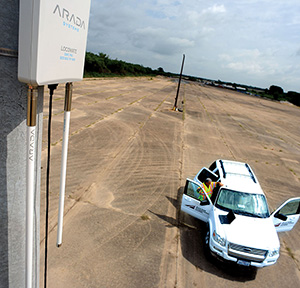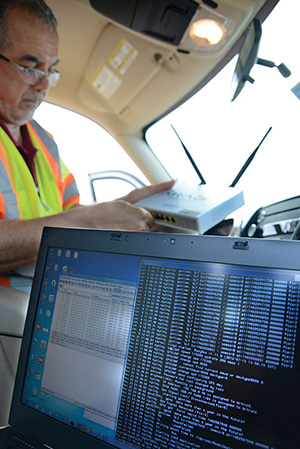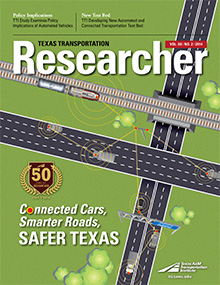
The Texas A&M Transportation Institute (TTI) shares an industry vision where vehicle collisions are eliminated. Vehicles will interact — through technology — with other vehicles, drivers, the infrastructure, pedestrians and bicyclists to prevent crashes. The entire transportation system will be connected in a way that transforms how people live, work and interact. Achieving this vision requires research, development and testing on how vehicles, users, telematics and infrastructure all work together via vehicle-to-infrastructure or infrastructure-to-vehicle communication.
Along with the Accelerate Texas Center, TTI’s Connected Transportation Initiative will include a world-class automated and connected transportation system testing facility at Texas A&M University’s Riverside Campus. The test bed is an initial step in TTI’s goal to build awareness and will ensure the Institute can develop the necessary firsthand experience in integrating field infrastructure and vehicle components, as well as specific applications for both technologies. Lessons learned and success in developing applications in the test bed environment will facilitate the implementation of pilot deployments on strategic roadway corridors, showcase TTI’s capabilities to potential sponsors, and help obtain new funding for full deployments. Early efforts in designing, installing and testing some technologies on the test bed are already resulting in promising developments.
Concept of Operations and Equipment Installation

Leading the development effort, TTI Associate Research Engineer Rajat Rajbhandari and a multi-program research team have purchased the necessary dedicated short-range communication equipment, which consists of onboard radios used to retrofit test vehicles and roadside equipment so that they communicate with each other and with drivers. According to Rajbhandari, “Once we get the equipment installed at the Riverside Proving Grounds, we will test three work-zone applications that send motorists in-vehicle alerts of upcoming lane closures, queue warnings and other hazardous situations. We will also better understand how to get this technology into real-world deployments, the technology’s strengths and limitations, as well as requirements for integrating with roadway infrastructure.”
The next phase of test bed development is to finalize the concept of operations document, including a high- and mid-level conceptual architecture based on the U.S. Department of Transportation’s Connected Vehicle Reference Implementation Architecture. “This will allow us to develop and test more extensive connected- and automated-vehicle applications inside and outside the Riverside Campus,” says Rajbhandari.
Creating “Smart” Pavement Markings
TTI Operations and Roadway Safety Division Head Paul Carlson and TTI Research Scientist Mohammad Poorsartep, project manager for the Institute’s Connected Transportation Initiative, have consulted with various car companies, tier one suppliers, state departments of transportation and pavement-marking industry professionals to discuss the current camera-based technologies used in vehicle-lane keeping and lane-departure warning systems.
TTI is already recognized as one of the premier university-based research organizations regarding pavement-marking materials, visibility and performance. This project is focused on expanding the traditional infrastructure-oriented pavement-marking research to include enhanced pavement markings that will support automated vehicle deployment and identify possible limitations, areas for further research and new applications.
Researchers are using TTI’s one-of-a-kind Visibility Research Lab to test the performance of various camera-based systems in detecting existing and prototype pavement markings. The testing will include low-visibility conditions simulating heavy rains, thick fog and low sunlight, which cause high glare. Additionally, researchers will investigate new sensing technologies to further enhance pavement-marking detection. Promising technologies will then be evaluated at the new Riverside test bed.
“The goal is to work with both infrastructure owners/operators and vehicle manufacturers to overcome the limitations that currently exist with today’s camera-based systems,” says Carlson. “In terms of priorities, vehicle manufacturers have repeatedly identified pavement markings as the most valuable infrastructure element to promote automated-vehicle deployment.”
Following the arrival and installation of various pavement-marking samples and camera systems, evaluation at the Riverside test bed will begin.
